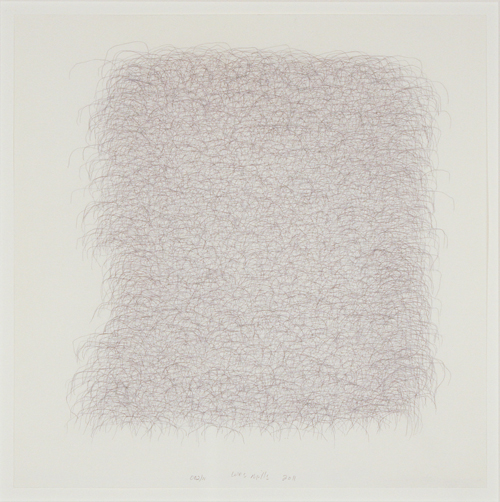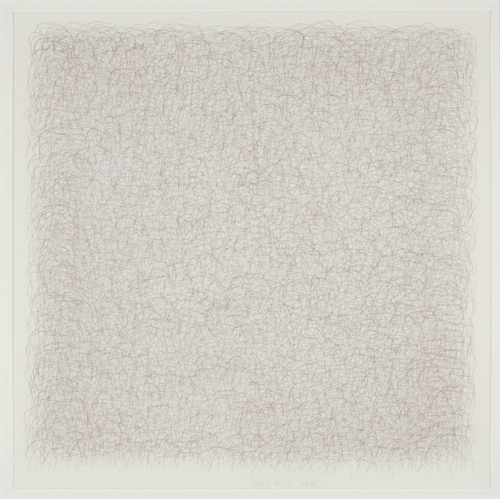
Steel and Graphite at James Kelly
The latest show at James Kelly presents two artists, Aldo Chaparro and Wes Mills, whose work couldn’t be more different. Chaparro, based in Mexico City, came to Santa Fe to fabricate his large stainless steel sculptures, for his inaugural show at James Kelly, I’ve Lost Control Again, which opened on October 19. Wes Mills is a draftsman who relocated from Taos to Montana and whose new body of work opened the same night in a show called To Tease a Hummingbird. His drawings unfold from the simplest of means, a single graphite line.
Rather than shipping his work, Aldo Chaparro artist arrived early with his assistant to bend and contort the large rolls of very thin steel into sculptures. Most of them hang on the wall and instantly suggest tinfoil or oversized candy wrappers (with a Jeff Koons-ish patina), predominately colored in jewel tones.

Acero #9 is silver and catches glimmers of pink and lime from its neighbors. It’s a large rectangle at 43″ x 66″ with a crumpled center and kinked edges. The whole object slants diagonally, hanging by a single screw, and suggests a lightweight material that is easily manipulated. Jeff Koons’ notions of low and high art are an interesting precursor to Chaparro’s ventures into glorified trash. Acero #9 looks as mutable as kitchen foil and as disposable as a New Year’s Eve decoration.
Part of its buoyancy arises from the reflected light. James Kelly’s white cube setting allows for mostly white refractions. Small splotches of the electrostatic paint colors magenta, teal, purple, and lime green sparkle here and there. Acero #3 boasts watery aquas and teals from the sky’s reflection through gallery windows. A passerby’s mirror image is barely captured, small and skewed by the folds of metal.
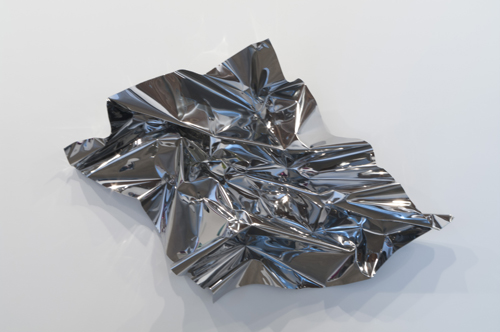
In place of the flamboyant bouncing light, Acero #7 has a matte finish on which is superimposed an inkjet black-and white likeness of a classical Greek bust. This work is smaller at 25 “x 23”, a scale that references portrait painting. Photographed, printed on stainless steel, bent and contorted, this Greek bust is an unexpected image from the past that appears crumpled and near disposal like a piece of paper. Antiquity intercedes in work that elsewhere seems to pay homage to John Chamberlain’s crushed cars. 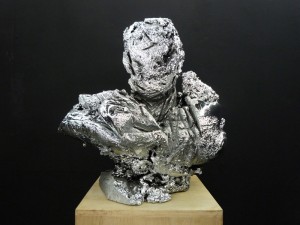 Furthermore, Chaparro’s Koons-polish seems at odds with classical Greek sculpture but consider a work not shown at James Kelly by the artist, Heroe (2012), a chrome polyurethane bust that looks corroded. The surface appears rough and eaten away the way oil paints eat through paper without a mediator. Acero #7‘s attempt to ruffle art history lacks followthrough when compared to Heroe, whose chrome surface appears to eat away at the organic form beneath.
Furthermore, Chaparro’s Koons-polish seems at odds with classical Greek sculpture but consider a work not shown at James Kelly by the artist, Heroe (2012), a chrome polyurethane bust that looks corroded. The surface appears rough and eaten away the way oil paints eat through paper without a mediator. Acero #7‘s attempt to ruffle art history lacks followthrough when compared to Heroe, whose chrome surface appears to eat away at the organic form beneath.
Koons’ mockery of classical sculpture is inescapable in informing Chaparro. Kiepenkerl, cast in 1987 out of stainless steel is as shiny as a Christmas ornament, but forms the statue of a peddler frozen indefinitely as a polished pedestrian salesman. No heroes here.
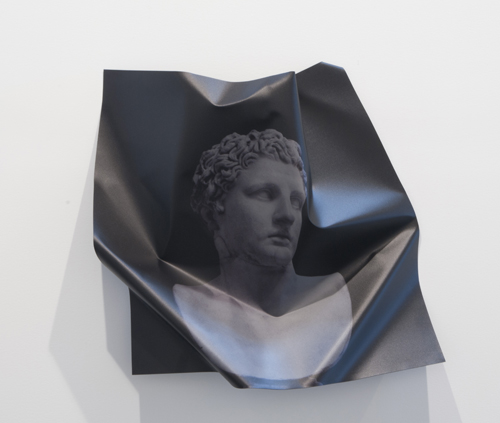
Wes Mills works on a small scale with paper and pencil. His show, To Tease a Hummingbird, presents over a dozen works with a group of drawings all framed at 17.25 x 17.25. These pieces unite with the same deliberate line, a small short mark about an inch wide that looks like an unsteady arch. It’s thin and wavers, sometimes lightly trailing on one end. It is repeated ad infinitum and this repetition establishes variation in line quality. He layers the arch continuously, and cumulatively makes marks uncountable.

Inside these spidery compositions little buildings grow from the interlaced archways and cities form from the system of spindly graphite lines. Sol Lewitt’s wall drawings come to mind. Wall Drawing #65 (1971) instructs, “Lines not short, not straight, crossing and touching, drawn at random […], uniformly dispersed with maximum density, covering the entire surface of the wall.” Mills does not draw on the wall but does revisit the fundamentals of drawing that begin with line. His drawings are intimate and encourage the viewer into their frames. Despite their untitled titles each one is different with a slightly different system within its matrix. Up close, one drawing reveals traces of yellow lines faded beneath the gray graphite. Another has faded blues. As the arches reach the outside, their spidery legs fray the edge, eventually leaving a bare border. At a distance, each work shares a compositional structure wherein a single rectangular shape that looks like static fills the paper.
